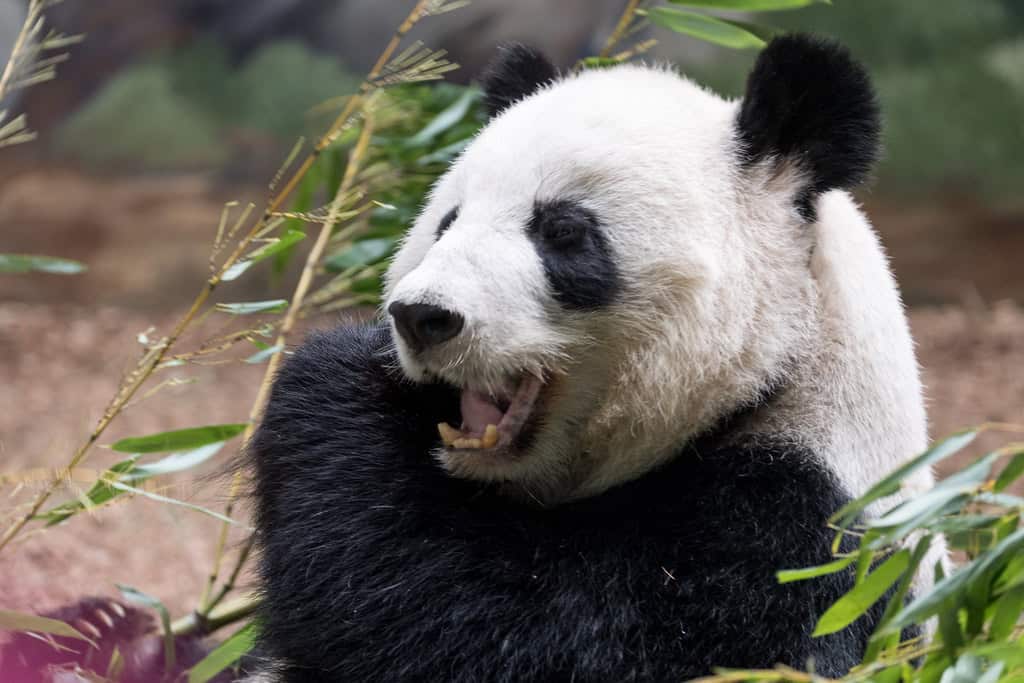For the iconic giant panda, bamboo is far more than just a food source—it’s the central pillar around which their entire existence revolves. These beloved black and white bears have evolved over millions of years to become specialized bamboo-eating machines, with their survival, behavior, habitat selection, and even reproduction intrinsically linked to this remarkable plant. Giant pandas consume bamboo for up to 14 hours daily, processing 9-14 kg (20-30 pounds) of the tough plant material to extract sufficient nutrition from this challenging diet. This remarkable dietary specialization has created one of nature’s most fascinating ecological relationships, where a single plant genus fundamentally shapes every aspect of a magnificent animal’s life.
The Panda’s Evolutionary Journey to Bamboo Specialization
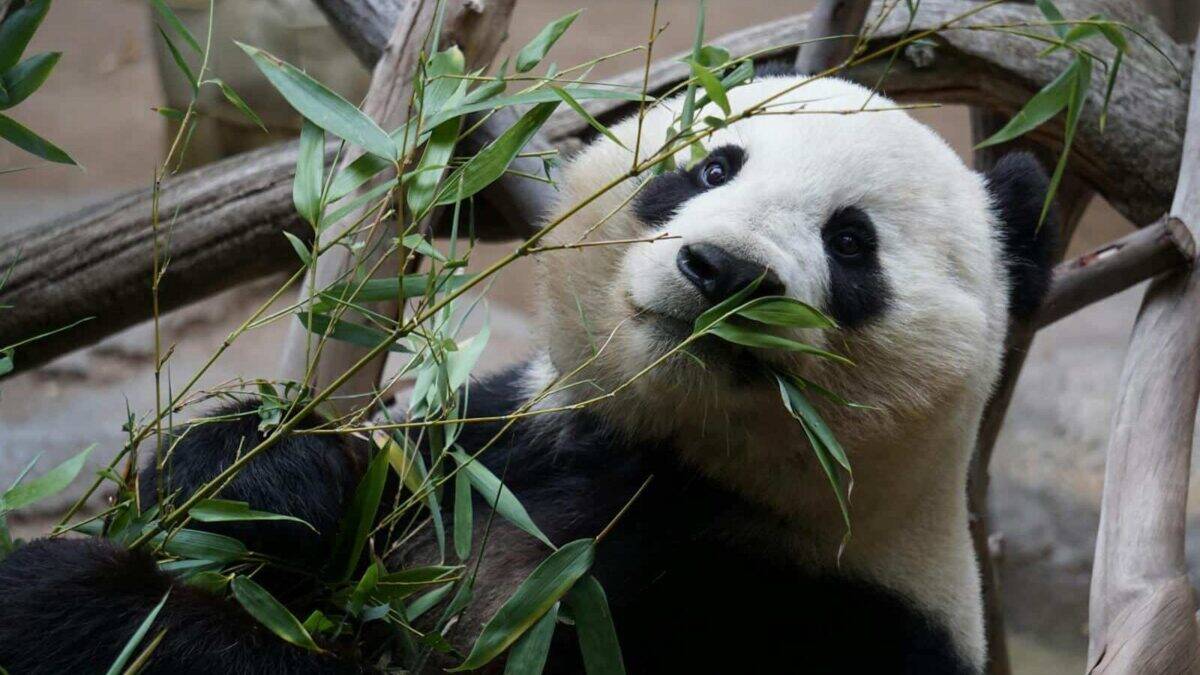
Giant pandas (Ailuropoda melanoleuca) share ancestors with other bears but took a dramatically different evolutionary path. While their carnivorous relatives continued to thrive on meat-based diets, pandas underwent remarkable anatomical changes to accommodate a shift toward herbivory approximately 2-3 million years ago. This dietary specialization is particularly surprising considering pandas belong to the order Carnivora and retain a carnivore’s digestive system—a relatively short gut not optimized for plant digestion.
The most visible adaptation is their distinctive “pseudo-thumb,” a modified wrist bone that allows pandas to grasp bamboo stems with remarkable dexterity. Their massive jaw muscles and specialized flat molars evolved to crush and grind tough bamboo. Their skull developed into a robust structure capable of withstanding the tremendous forces generated when crushing bamboo stems. These evolutionary adaptations reflect the profound influence bamboo has had on panda physiology, gradually reshaping these bears into highly specialized bamboo-processing machines despite their carnivorous ancestry.
Bamboo: A Challenging Nutritional Foundation

Bamboo presents a remarkably challenging nutritional foundation for any animal. It contains minimal calories, limited protein, and high fiber content, with much of its mass being indigestible cellulose. The plant further defends itself with silica crystals that rapidly wear down teeth. Despite these challenges, pandas have committed almost exclusively to this diet, with bamboo representing approximately 99% of their food intake in the wild. They manage this nutritional puzzle by consuming enormous quantities—adult pandas spend 10-14 hours eating daily, processing up to 14 kg of bamboo.
To extract maximum nutrition, pandas employ selective feeding strategies. They preferentially choose shoots and leaves during spring and summer, which contain more protein and nutrients, then shift to stems during winter when other parts become scarce. Research indicates pandas digest only about 17% of the bamboo they consume, explaining their need for such massive intake volumes. This inefficient digestion also accounts for the panda’s relatively sluggish lifestyle—they simply cannot extract enough energy from bamboo to support more vigorous activity. Despite being physiological carnivores, they’ve made this remarkable nutritional compromise work through sheer volume and specialized feeding behavior.
The Panda’s Daily Bamboo Routine

A giant panda’s daily schedule revolves almost entirely around bamboo consumption. They typically wake at dawn to begin their first feeding session, which usually lasts 2-4 hours. Unlike many other bears, pandas don’t hibernate, as their bamboo diet doesn’t allow them to build sufficient fat reserves. Instead, they maintain a year-round pattern of alternating between feeding and resting periods. After the morning feeding session, pandas typically rest for several hours to digest before beginning another extended feeding period in the afternoon and evening.
This constant cycle of eating and digesting shapes their daily movements and activity patterns. Pandas typically eat in a seated position, using their pseudo-thumb to grasp bamboo stems while their powerful jaws and teeth strip off leaves or crack stems to access the softer tissues inside. They may consume over 40 pounds of bamboo on some days. The amount of time dedicated to feeding leaves little energy for other activities, explaining why pandas appear sedentary compared to other bears. Their daily routine of methodical bamboo processing is one of nature’s most specialized feeding adaptations, allowing them to survive on a food source few other mammals could utilize as a primary diet.
Anatomical Adaptations for Bamboo Processing
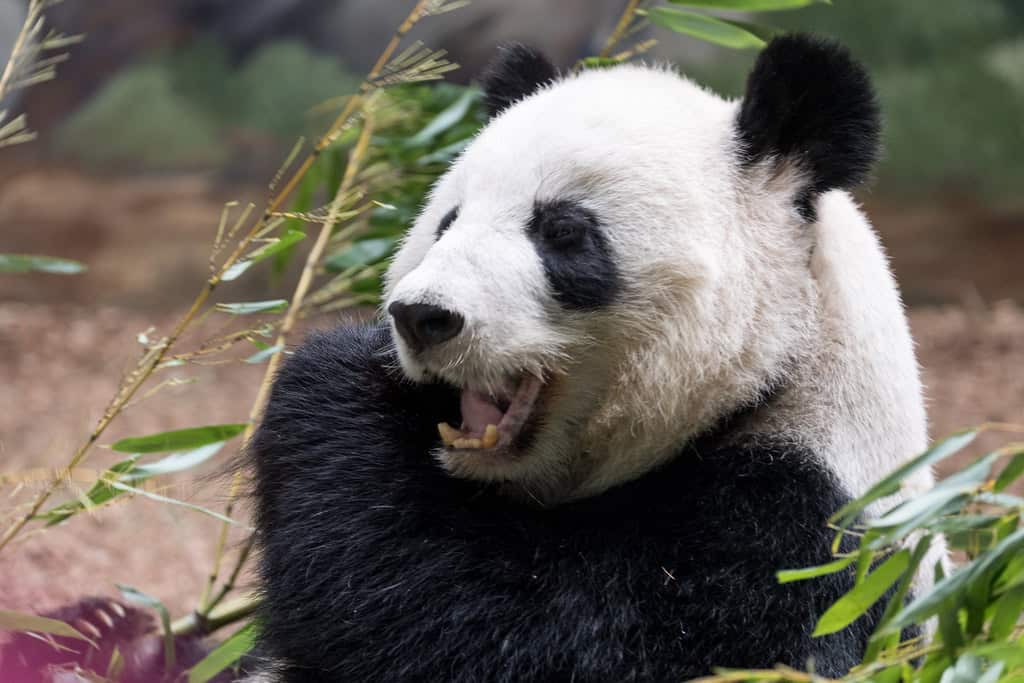
The giant panda’s body exhibits remarkable specializations for bamboo consumption. Most notable is their “pseudo-thumb,” a modified sesamoid bone that extends from their wrist. This adaptation, which evolved around 6-8 million years ago, functions as an opposable digit that enables pandas to grasp bamboo stems with precision. Their skull structure has also been dramatically modified, featuring expanded temporal regions that accommodate massive jaw muscles capable of generating tremendous bite force—estimated at 292 pounds of force—necessary for crushing bamboo stems that can be as hard as lightweight wood.
Their dentition further reflects bamboo specialization, with large, flat molars ideal for grinding fibrous plant material rather than the sharp, cutting teeth typical of carnivores. The digestive system, however, retains the short, simple structure characteristic of carnivores, lacking the specialized chambers and microbial communities that most herbivores use to break down plant matter. This creates a physiological paradox—pandas have the feeding apparatus of an herbivore but the digestive system of a carnivore. They compensate for this mismatch through their feeding strategy, volume of consumption, and selective foraging behaviors that target the most nutritious bamboo parts available in each season.
Bamboo Forests: The Perfect Panda Habitat
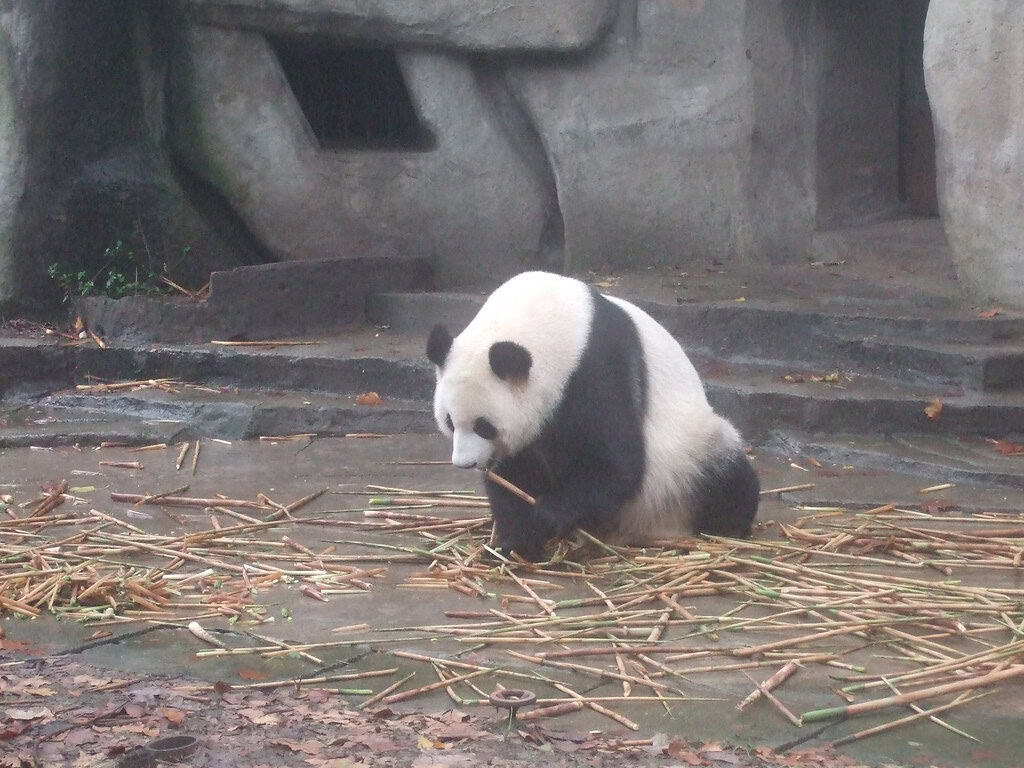
Giant pandas require specific forest habitat characterized by abundant bamboo understory at multiple growth stages. Historically, they ranged throughout much of southern and eastern China, northern Myanmar, and northern Vietnam, but today are restricted to isolated mountain ranges in central China’s provinces of Sichuan, Shaanxi, and Gansu. The ideal panda habitat features dense bamboo forests at elevations between 5,000 and 10,000 feet, where cool, moist conditions support vigorous bamboo growth. These areas typically receive 30-75 inches of annual rainfall and maintain high humidity, creating perfect conditions for bamboo proliferation.
Pandas show strong preferences for forests containing multiple bamboo species, as this diversity provides nutritional insurance against the periodic die-offs that affect bamboo after flowering events. A suitable habitat must also include sufficient den sites, usually hollow trees or natural rock crevices, for female pandas to raise their vulnerable cubs. The fragmentation of these specialized forest habitats represents one of the greatest threats to wild panda populations. Conservation efforts have increasingly focused on protecting bamboo corridors between isolated panda populations, recognizing that the preservation of these bears depends entirely on maintaining healthy, connected bamboo forest ecosystems.
The Bamboo Flowering Crisis
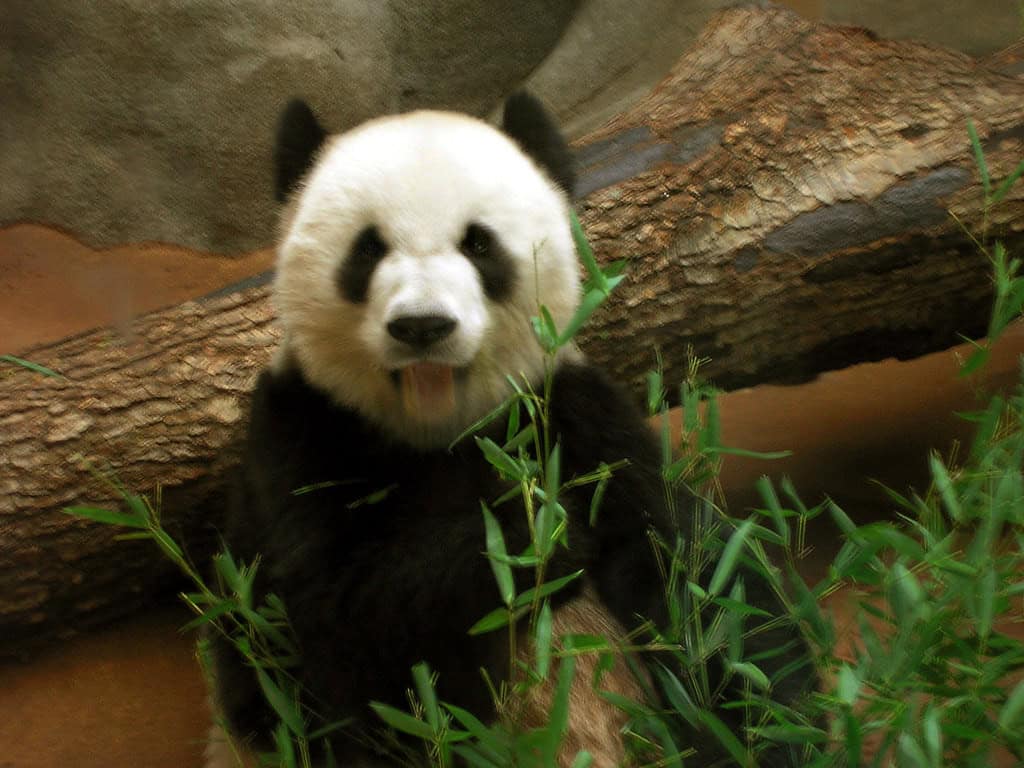
One of the most dramatic ways bamboo influences panda life involves the plant’s unusual reproductive cycle. Most bamboo species flower synchronously on cycles ranging from 10 to 120 years, depending on the species. When flowering occurs, entire bamboo populations reproduce simultaneously, set seed, and then die. This mass flowering phenomenon creates periodic food crises for pandas, who suddenly find their primary food source disappearing across large areas. Historically, pandas would migrate to areas with different bamboo species or different flowering cycles, but habitat fragmentation has made such movements increasingly difficult.
The consequences of these flowering events can be devastating. Between 1983 and 1996, a mass flowering and die-off of arrow bamboo (Fargesia spathacea) in China’s Wolong Nature Reserve resulted in the deaths of approximately 200 pandas—nearly 30% of the wild population at that time. This event highlighted the vulnerability of pandas to these natural bamboo cycles. Conservation strategies now include careful monitoring of bamboo flowering patterns, establishing reserves with multiple bamboo species on different flowering cycles, and developing emergency response plans for supplemental feeding when necessary. The intimate connection between panda survival and bamboo life cycles demonstrates just how completely these bears’ existence depends on the peculiarities of their chosen food plant.
Bamboo’s Influence on Panda Reproduction
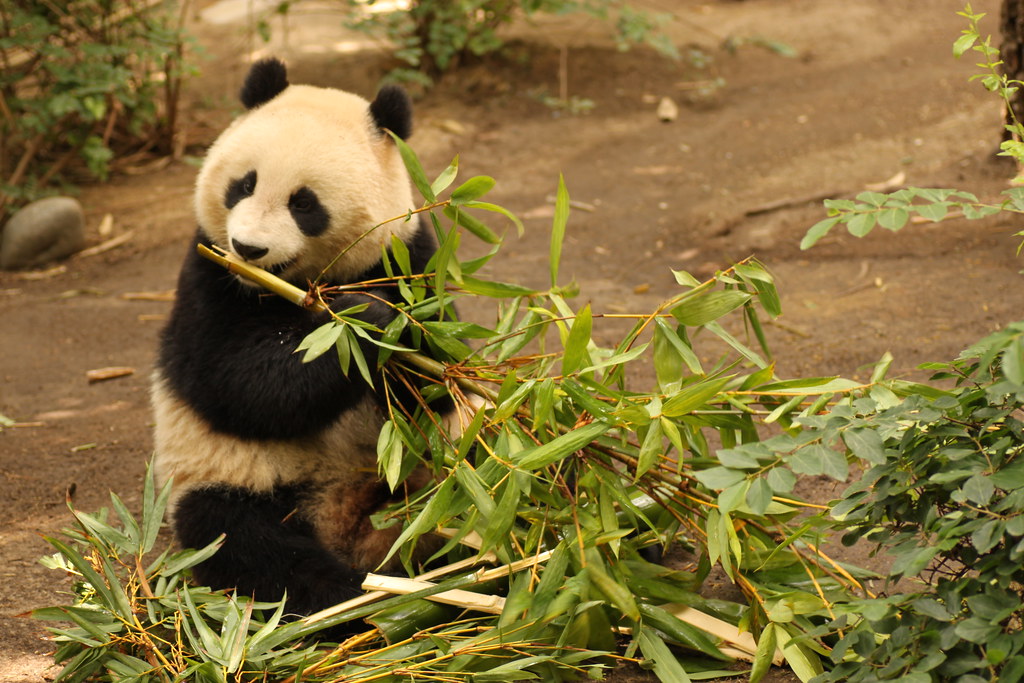
Bamboo’s limited nutritional value profoundly affects panda reproduction, creating one of the animal kingdom’s most challenging reproductive scenarios. Female pandas ovulate just once annually, giving a narrow 24-48 hour window for successful breeding. This limited fertility combined with the pandas’ naturally solitary lifestyle—a behavior pattern that conserves energy given their poor diet—makes reproduction exceptionally difficult. The nutritional constraints imposed by the bamboo diet are believed to be a primary factor in pandas’ low reproductive rate, as females must accumulate sufficient fat reserves to support pregnancy and lactation.
Newborn panda cubs are extraordinarily underdeveloped compared to other bear species, weighing just 90-130 grams—about 1/900th of their mother’s weight. This extreme altriciality (birth in an undeveloped state) is another adaptation to the mother’s limited energy budget from her bamboo diet. Unlike other bears that can support larger, more developed cubs, panda mothers must minimize initial investment in offspring. The timing of breeding is also synchronized with periods of maximum bamboo nutrition, particularly the spring emergence of protein-rich shoots. These reproductive adaptations reflect how completely bamboo has shaped even the most fundamental biological processes of the panda’s life cycle.
Seasonal Shifts in Bamboo Selection
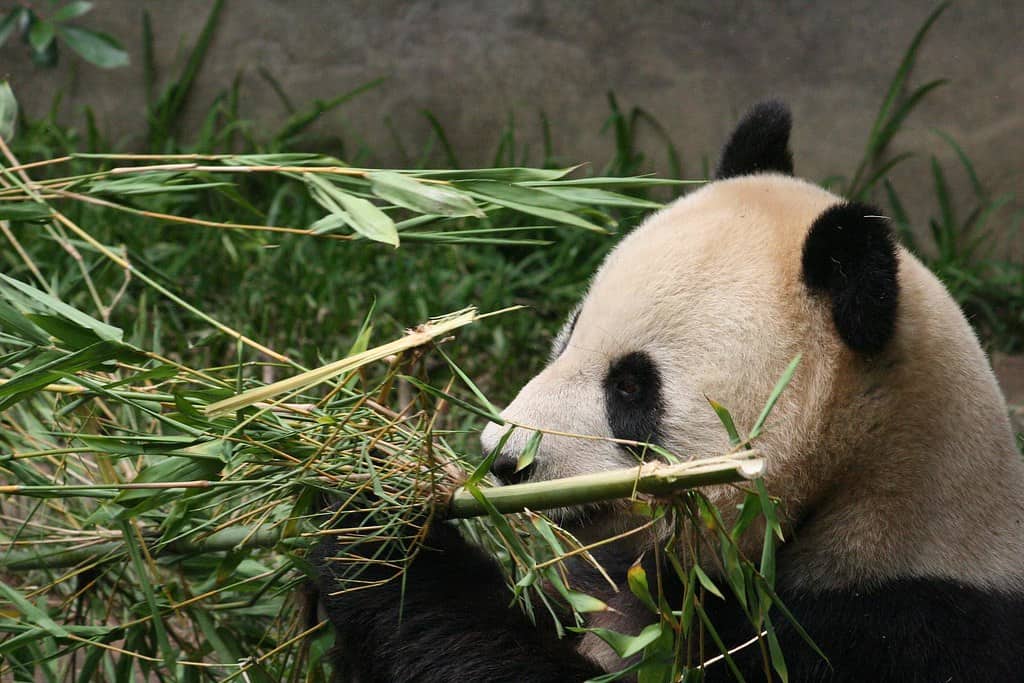
Giant pandas display remarkable selectivity in their bamboo consumption throughout the year, adjusting their feeding behavior to target the most nutritious parts of the plant as they become seasonally available. During spring and early summer, pandas focus heavily on young shoots, which emerge tender and packed with protein and lower in fiber than mature bamboo. These shoots can contain up to 32% protein (dry weight), compared to just 1-3% in mature stems, making them nutritional goldmines. Studies show pandas may travel considerable distances to locate areas with emerging shoots, demonstrating their acute awareness of this high-value food resource.
As summer progresses into fall and winter, pandas transition to consuming primarily leaves, which offer better nutrition than stems but less than shoots. During the harshest winter months when other options are limited, pandas rely more heavily on stems, stripping away the outer layer to access the slightly more nutritious inner tissues. They also adjust their selection among bamboo species seasonally—in regions with multiple bamboo types, pandas may focus on umbrella bamboo (Fargesia robusta) during winter and arrow bamboo (F. spathacea) during summer. This sophisticated seasonal foraging strategy represents a critical adaptation to maximize nutritional intake from their challenging food source, highlighting how intimately pandas understand the nutritional landscape of their bamboo forests.
The Social Impact of Bamboo Distribution
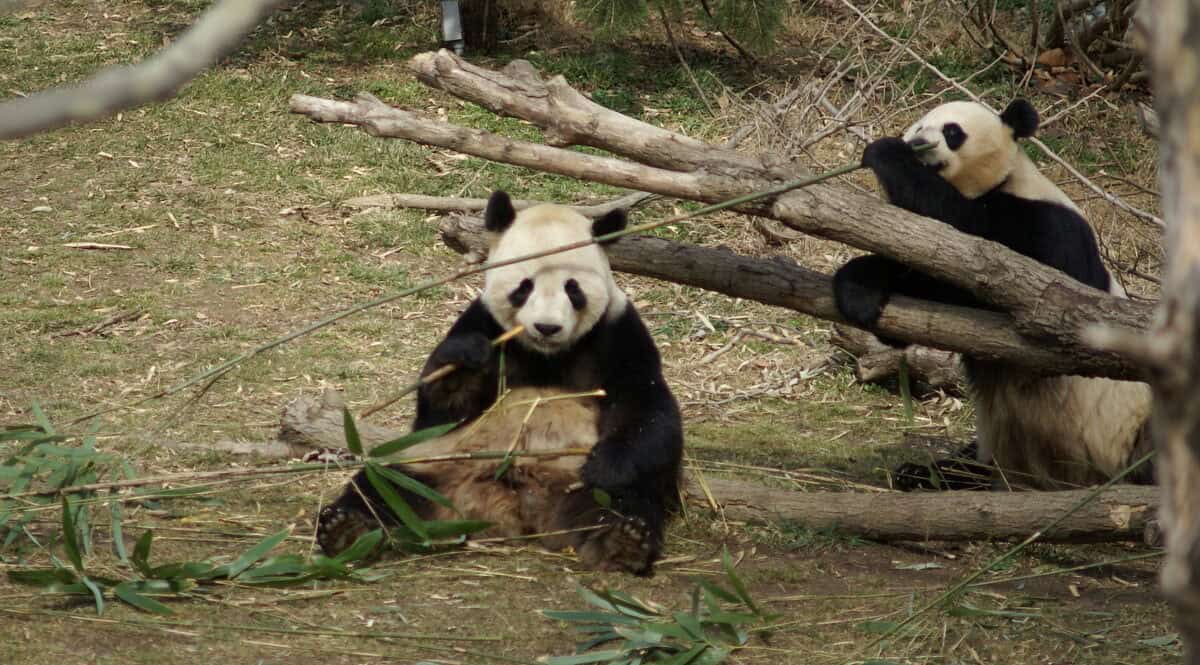
Unlike most bear species that establish and defend territories, giant pandas exhibit a unique social structure directly shaped by bamboo distribution. Adult pandas are primarily solitary, maintaining overlapping home ranges rather than exclusive territories. This social arrangement reflects bamboo’s unique properties as a food resource: it’s abundant but nutritionally poor, distributed in patches, and requires minimal competition. Since bamboo exists in such quantities that multiple pandas can feed in the same general area without depleting it, aggressive territorial defense would waste precious energy that pandas cannot afford to spare.
Communication between pandas occurs primarily through scent marking rather than direct interaction. They leave chemical signals on trees and rocks using glandular secretions and urine, creating an olfactory map that helps pandas understand the location and reproductive status of other individuals without needing to encounter them directly. This chemical communication system allows pandas to maintain social awareness while minimizing energy-expensive physical interactions. Female home ranges typically cover 3-6 square kilometers, while males maintain larger ranges of 6-10 square kilometers that may overlap with several females. This spatial organization optimizes access to bamboo resources while providing breeding opportunities—another example of how completely bamboo shapes panda social dynamics.
Bamboo Specialization as a Conservation Challenge
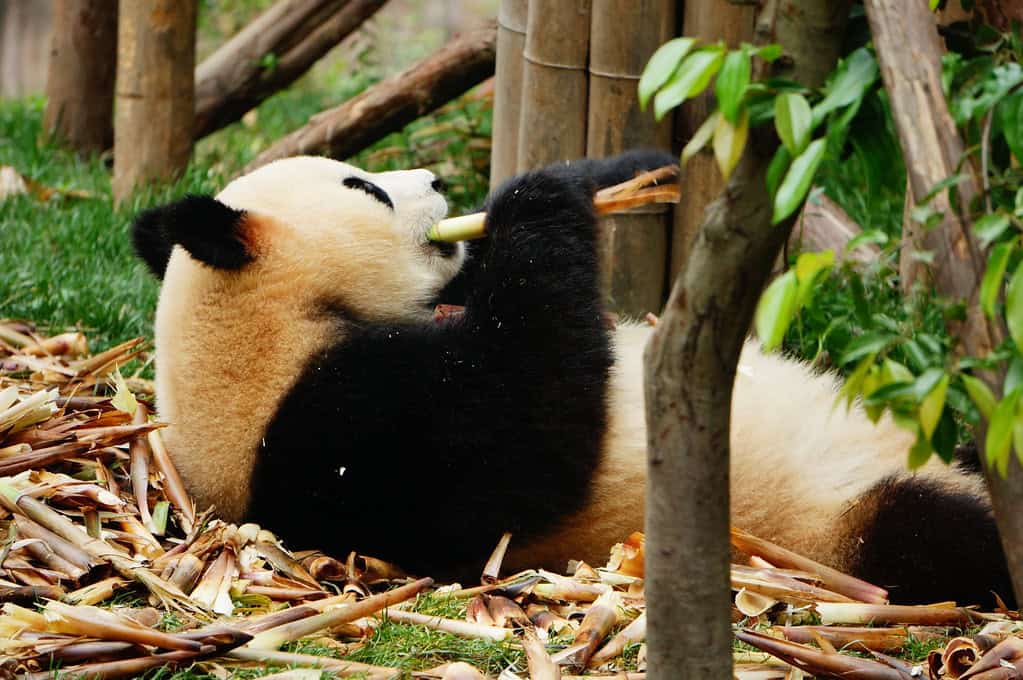
The giant panda’s extreme specialization on bamboo creates unique conservation challenges. With approximately 99% of their diet coming from a single plant genus, pandas are extraordinarily vulnerable to habitat changes that affect bamboo availability. Climate change poses a particular threat, as shifting temperature and precipitation patterns could alter the distribution of bamboo species across mountainous regions. Research suggests that climate change could reduce suitable bamboo habitat by 35-60% by the end of the century. This specialization also means pandas cannot easily adapt to alternative food sources when bamboo becomes scarce.
Conservation strategies must address these specialized needs through targeted approaches. Protected areas must contain multiple bamboo species with different flowering cycles to provide nutritional security. Connectivity between panda populations is essential to allow movement during localized bamboo die-offs. Restoration efforts focus specifically on reestablishing bamboo understory in degraded forests. The pandas’ dietary inflexibility also complicates captive breeding programs, requiring zoos to secure reliable bamboo supplies—many facilities must grow their own or develop networks of bamboo suppliers to maintain adequate nutrition for their animals. These unique challenges make panda conservation particularly complex compared to more adaptable species.
The Ecological Role of Pandas in Bamboo Forests
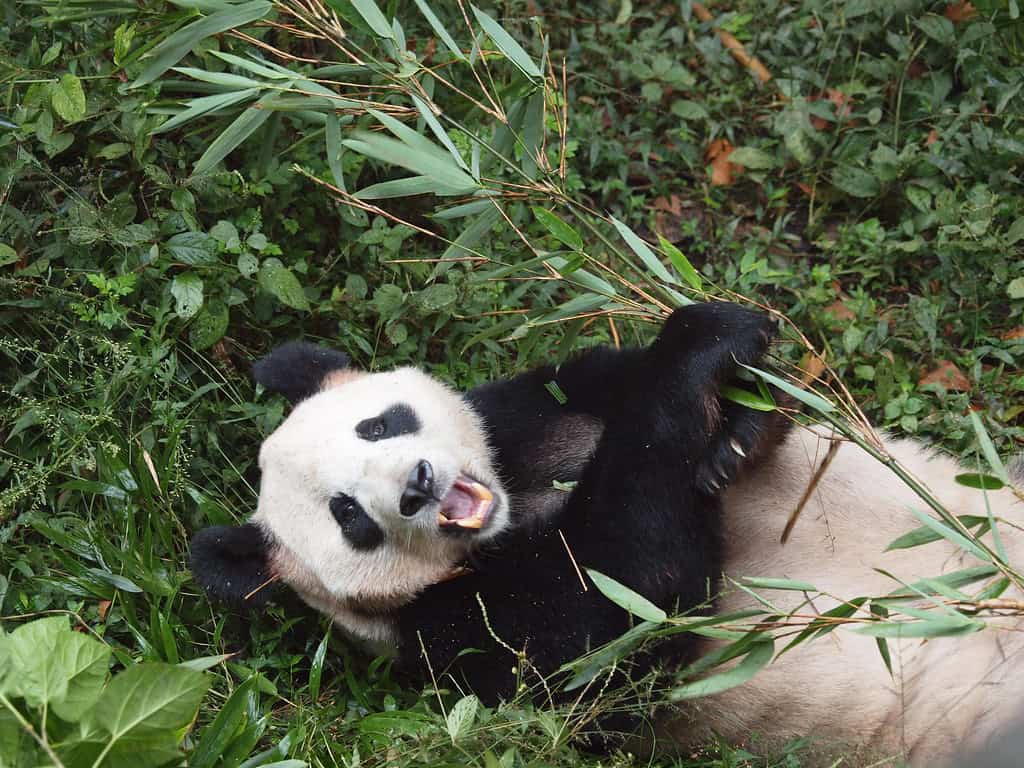
Despite their specialized diet, giant pandas play subtle but important ecological roles in their bamboo forest ecosystems. As they move through their habitat, pandas create small disturbances that influence forest dynamics. Their selective feeding behavior helps shape bamboo community structure by affecting which plants and plant parts remain to grow and reproduce. Pandas may also contribute to bamboo seed dispersal during the rare periods following mass flowering events, when they sometimes consume seeds along with other bamboo parts.
The panda’s ecological influence extends beyond their direct interactions with bamboo. Their feces, composed largely of undigested bamboo fiber, contributes to nutrient cycling within the forest ecosystem and may serve as a growth medium for certain fungi and microorganisms. Additionally, the conservation efforts directed at protecting pandas have created an “umbrella effect” that benefits countless other species sharing the same habitat. By necessitating the protection of large tracts of bamboo forest, pandas indirectly safeguard biodiversity throughout these mountain ecosystems. The relationship between pandas and their bamboo forests represents a remarkable case of co-evolution, where a specialized herbivore has become both dependent on and influential within its ecosystem.
Conclusion: A Life Defined by Bamboo
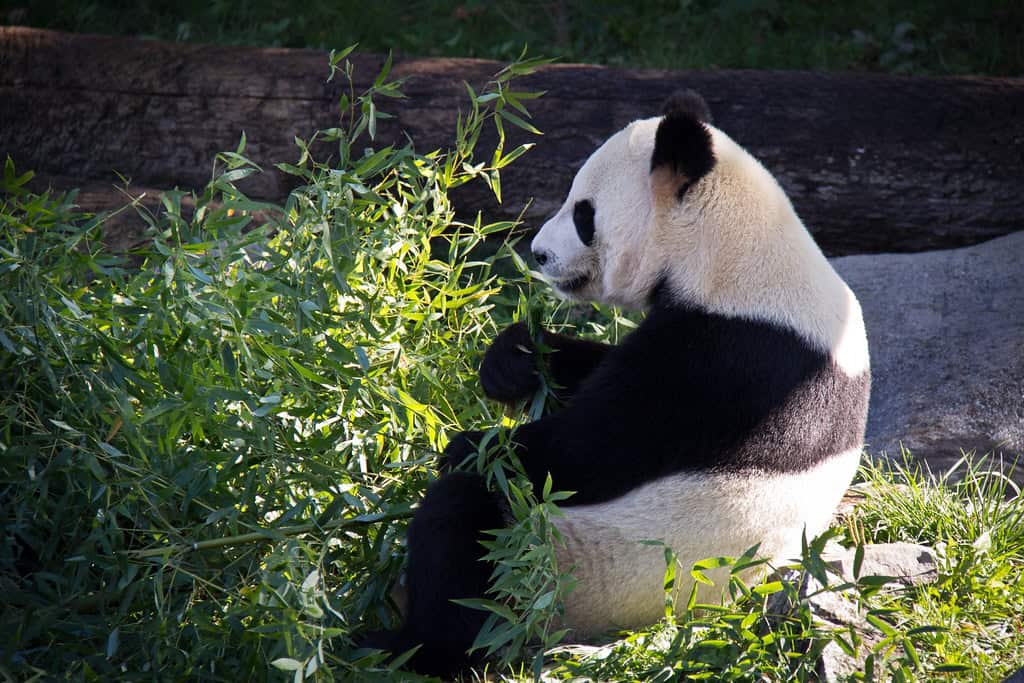
The extraordinary relationship between giant pandas and bamboo represents one of nature’s most remarkable examples of evolutionary specialization. From their distinctive physical adaptations like the pseudo-thumb and powerful jaw muscles to their carefully calibrated seasonal feeding strategies, every aspect of panda biology reflects their commitment to this challenging dietary path. Their daily routines, reproductive patterns, social structure, and even their very survival as a species are inextricably linked to the peculiarities of bamboo as a food source.
This specialization has created both the panda’s iconic uniqueness and its vulnerability in a rapidly changing world. As we work to conserve these beloved animals, understanding the central role bamboo plays in their lives becomes essential for developing effective protection strategies. The panda-bamboo relationship reminds us of the complex interdependencies that exist throughout nature, where species evolve in response to their ecological context, sometimes taking evolutionary gambles on specialization.
Despite the nutritional challenges bamboo presents, pandas have thrived on this diet for millions of years, perfecting their adaptations and carving out a unique ecological niche that no other mammal occupies. Their story is one of remarkable evolutionary commitment—a bear family member that abandoned the typical carnivorous path to become one of the most specialized herbivores on Earth. The giant panda stands as living proof that evolutionary success can come through specialization as well as adaptability, even when that specialization centers on one of nature’s most nutritionally challenging food sources.
As we continue to protect these magnificent animals and their bamboo forest habitats, we honor not just an iconic species but one of evolution’s most fascinating experiments—a case study in how completely a single plant can shape every dimension of an animal’s existence.
- The Only Mammal That Can Breathe Through Its Skin - August 19, 2025
- How to Win Over Judges in Dressage Competitions - August 19, 2025
- Is There Hope for the Critically Endangered Amur Leopard? - August 19, 2025

